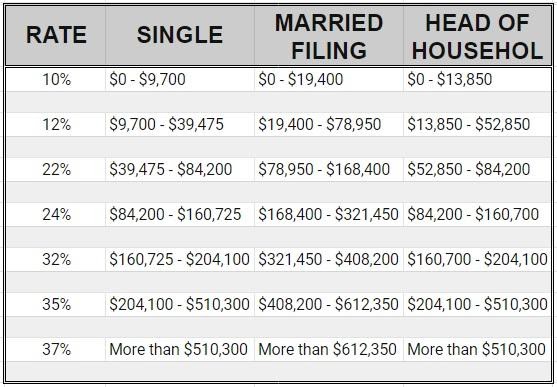The IRS frequently adjusts its tax brackets to ensure they’re fair and consistent with inflation. In 2020, the IRS made several changes based on the latest economic data. In this post, we’ll cover the new tax brackets for 2020 and other crucial details.
This post is outdated, but you can find the latest information on tax brackets and deadlines using the link below.
>> Get the updated tax brackets for 2024 here <<
How Do Tax Brackets Work
Tax brackets determine your annual tax rate. Tax brackets vary depending on the taxable income. The tax bracket you are in will depend on your taxable income and filing status you are choosing to file under. You can file as single, married, or head of household. To qualify as head of household you must meet the following criteria:
- Pay for more than half of all household expenses
- Be considered unmarried for the year
- Have at least one qualifying child or dependent
Tax brackets charge higher-income earners higher tax rates than lower-income taxpayers. All tax brackets are graduated, so all earned income isn�t taxed at the same percentage. This means that your income up to the bracket maximum is assessed at that bracket’s tax rate and so on. Income earned over the previous bracket’s threshold is taxed at the next bracket’s rate. That is why someone who makes above half a million dollars is paying so much on every additional dollar earned.
What Are the New Tax Brackets?
Tax brackets recently changed as a result of the Tax Cuts and Jobs Act. The TCJA reduced statutory tax rates for most income limits and shifted the thresholds for several income limits. These are the current tax brackets (as of January 1, 2020):
How To Determine Your Tax Rate
To determine your tax rate you will need to calculate your taxable income and determine the best way to file. To determine taxable income, calculating your gross income for the year and subtract any above-the-line deductions. An example of an above the line deduction would be contributions you make to your IRA. The IRS allows you to deduct up to the maximum contribution limit. Currently, the limit is $6,000. From here you can take your deductions, either standard or itemized. The result, after adjustments and deductions, is your net income, or your taxable income.
IRS Income Tax Help
Taxes are confusing for most taxpayers. For self-employed contractors, taxes are more confusing. Some tax situations that warrant the expertise of a tax advisor are:
- You have multiple streams of income
- Bought or sold a house
- If you own rental property
- You are planning for retirement
- Unsure whether you should itemize or take the standard deduction
- A change in marital status
- Income from more than one state
- Birth or adoption of a child
- Inheritance
One of the best parts about hiring a tax advisor is they know the tax code so you don�t have to. This can save you countless hours learning the tax code (have you seen how long the tax code is?). Plus they stay up to date on all the changes, and it is constantly changing. It’s a lot to keep up with. This doesn�t mean you shouldn�t ask questions. On the contrary, you can learn a lot about taxes from your tax advisor. This can help you make more educated decisions about your financial future moving forward. Your tax advisor can also help you determine which filing status best suits your tax situation and whether or not you should itemize or take the standard deduction.
Get Tax Help Now
Ultimately, many taxpayers hire a tax prep pro. It saves time and money, plus they know their taxes will be accurate and timely. To schedule a strategy session, contact one of the tax experts at Shared Economy today! To learn more about tax brackets or other self-employed tax tips subscribe to our newsletter.
